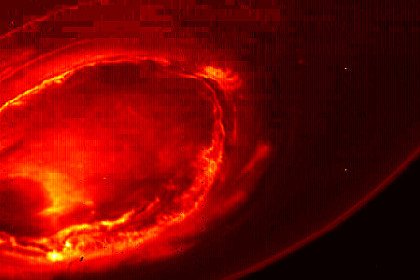
The spacecraft Juno ( «Juno") has transferred to the Earth unique pictures of Jupiter. Post about it on Friday, 2 September, published on the NASA website.
The pictures were taken on August 27 when the "Juno" has successfully made the first of his 36 turns around the planet. The probe was able to capture a celestial body in previously unseen ways. The first infrared image of Jupiter close-up were recorded.
"This is the first infrared views of Jupiter's north and south poles, showing warm and hot spots that we've never seen them before. And although we know that the world's first infrared views of Jupiter's south pole might reveal the aurora, we were amazed to see them for the first time. No other devices with the Earth or from space, could not fix the southern aurorae. The high level of detail to tell us more about Jupiter "- said the researcher scientific apparatus" Juno ", the Institute of Space Astrophysics and Planetology in Rome Alberto Adriani.
As explained by the head of the group involved in the mission of the Southwest Research Institute in San Antonio, Scott Bolton, of the pictures the north pole, you can get information about the storm system, the gas giant. "The pole was more blue than the rest of the world, and in this area a lot of storms. There's no signs familiar to us, for this picture one can hardly find Jupiter. We saw that the clouds have shadows, and it probably says that clouds are located at a greater height as compared to the other elements of the world ", - said Bolton.
Camera "Juno" helped take pictures of eight scientific apparatus, they were able to capture excellent views of Jupiter on its northern and southern polar regions in the infrared range.
"Saturn has the hexagon at the North Pole. Nothing similar to Jupiter is not. The biggest planet of our solar system is truly unique. And we have 36 more flybys to find out how it is unique in the fact ", - Bolton added.
Spacecraft «Juno» (Juno) was launched from Cape Canaveral on the Atlantic coast of Florida, USA, August 5, 2011. His goal - to study the gravitational and magnetic fields of Jupiter, as well as to test the hypothesis that the planet has a solid core
In orbit, the probe came out July 4th. "Juno" will run until February 2018, then leave orbit, will enter the planet's atmosphere and burn up there.

Source: http://www.nasa.gov/feature/jpl/jupiter-s-north-pole-unlike-anything-encountered-in-solar-system
